So you’ve bought the big kahuna of all ukuleles, the Baritone, and now you need to figure out how to tune the darned thing? Well, you’ve come to the right place.
In this article, we’ll attempt to cover every possible aspect of Bari uke tuning.
How are Baritone Ukuleles Tuned?
Baritone Ukuleles are traditionally tuned in the key of G with the notes D G B E. The D, G, and B are located just below middle C, and the E is located just above.

Contents
- How are Baritone Ukuleles Tuned?
- Tuning a Baritone Uke with Online Tuning Notes
- Step-By-Step Baritone Ukulele Tuning
- Other Baritone Uke Tuning Topics
- Baritone Ukulele Tuning Frequencies
- How to Tune a 6-String Baritone Ukulele
- How to Tune an 8-String Baritone Uke
- How to Tune a Baritone Banjo Ukulele
- The String Tensions of a Tuned Baritone Ukulele
- Baritone Ukulele Tuning vs. Soprano, Concert, and Tenor
- Can a Baritone Ukulele be Tuned to GCEA like a Soprano, Concert, and Tenor?
- What are the Common Chords for a Tuned Baritone Uke?
- What is the Scale of a Tuned Baritone Ukulele?
- What are the Fretboard Notes of a Tuned Baritone Uke?
- Pineapple Baritone Ukulele Tuning
- How to Tune the Baritone Ukulele
- Baritone Ukulele Tuning Mechanisms
- Frequently Asked Questions
- Conclusion
Tuning a Baritone Uke with Online Tuning Notes
Here’s a video which plays the 4 tones used in Baritone Ukulele tuning:
To tuned your Uke to the vid, start with loose strings. Then tighten each string while plucking it until the string’s pitch and the video’s pitch match.
A good way to tell if two pitches played at the same time are the in-tune is that there will be a slight hollow/clean quality to the sound and no “warble.”
Step-By-Step Baritone Ukulele Tuning
Baritone Uke Tuning By Ear (with Reference Note)
Tune your Baritone Ukulele to itself, by ear, with a reference note for the lowest string.
- Tune Your Top String to D
Find a source for the D pitch below middle C. This could be an in-tune keyboard/piano, a tuning fork, etc.
To tune the string to this pitch, start by loosening it.
Then, while playing the reference note, slowly tighten the string while plucking it until the string’s pitch and the reference pitch are identical. - Tune Your G String from Your D String
Now that your D string is tuned, you can move on to the G string.
Hold down your D string at the 5th fret and pluck it. This is the pitch you want to match your G string to.
Slowly tighten your loose G string until it matches that pitch. - Tune Your B String from Your G String
To get the pitch of your B string, hold down your G string at the 4th fret. Again, pluck this string while tightening your B string until they are in-tune. - Tune Your Bottom String to E from Your B String
Finally, hold your B string at the 5h fret and pluck it to get your E pitch. And as before, tighten your loose E string while plucking the B string (held at the 5th fret) until the pitches match.
Congratulations, you have tuned your Baritone Ukulele! Now get strumming!

Other Baritone Uke Tuning Topics
Besides step-by-step tuning, here are some other topics which related to Baritone Ukulele Tuning:
Baritone Ukulele Tuning Frequencies
The following is a table of the frequencies of the notes used in tuning a Baritone Uke:
| Note | Frequency |
| D (top string) | 146.83 (often rounded to 147) Hz |
| G | 196 Hz |
| B | 246.94 (often rounded to 247) Hz |
| E (bottom string) | 329.63 (often rounder to 330) Hz |
How to Tune a 6-String Baritone Ukulele
The standard way of tuning a 6-String Baritone uke is to double up the lowest and highest strings.
This means the D string and E string would be doubled up. So the final tuning would be DDGBEE.
Note: I have seen some 6-string Baritone ukes designed to be tuned like a guitar or with other strange tuning systems, so be sure to follow manufacturer instructions or look into your specific model’s designated tuning to avoid damaging your instrument.
How to Tune an 8-String Baritone Uke
An 8-string ukulele is typically tuned with each string doubled up in pairs which are played together.
So for a Baritone uke, this would translate to DDGGBBEE tuning, with each string doubled with an identical pair where each pair of strings is played together to produce a fuller sound.
How to Tune a Baritone Banjo Ukulele
As banjo ukuleles are tuned identically to their standard wood-body counterparts, the Baritone Banjo Ukuele is also tuned to DGBE tuning.
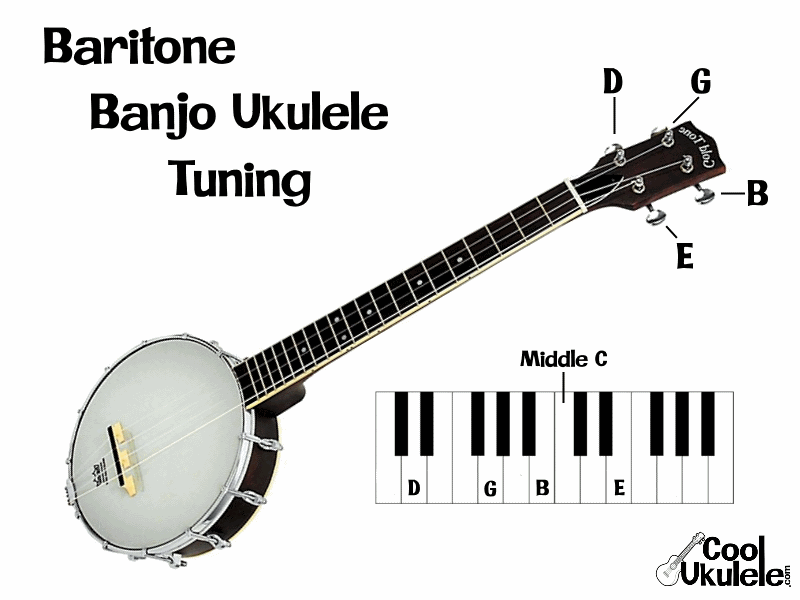
For more information on specific banjo ukulele tuning topics, check out our Banjo Ukulele Tuning article.
The String Tensions of a Tuned Baritone Ukulele
Here’s a table of the approximate string tensions for different baritone ukes:
| Ukulele Type | Approx. String Tension |
| 4 String Baritone Uke | Around 53 lbs. |
| 6 String Baritone Uke | Around 77 lbs. |
| 8 String Baritone Uke | Around 90 lbs. |
The larger the instrument (and the more strings used), the higher the tension the instrument is under.
Baritone Ukulele Tuning vs. Soprano, Concert, and Tenor
Most ukuleles (soprano, concert, and tenor) are traditionally tuned in C (GCEA) with a re-entrant G string.
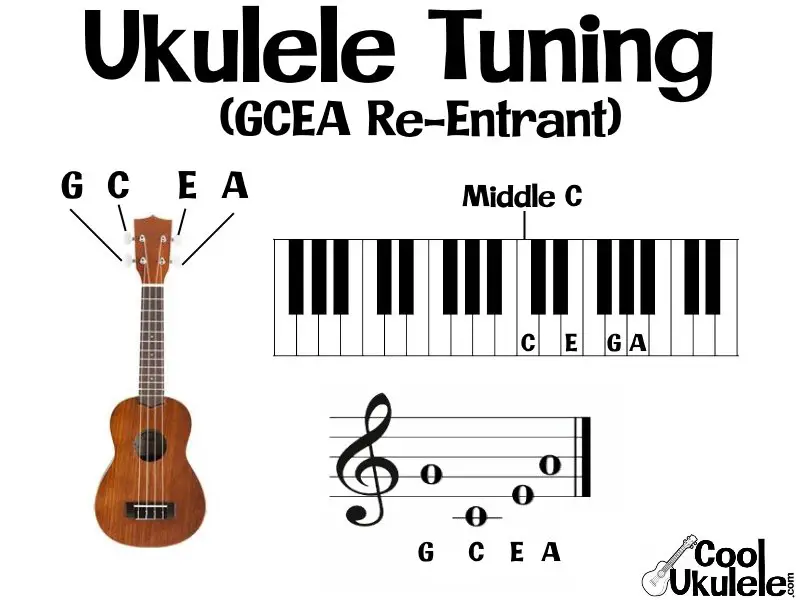
The Baritone, on the other hand, is tuned similar to guitar in G (DGBE) with a straightforward linear (low to high) tuning system.
This gives the Baritone a deeper, fuller, more guitar-like sound quality compared to its smaller siblings.
Its sound can almost be described as a hybrid between guitar and ukulele, combining the lightness of the ukulele with the richness of the guitar, though not fully either.
Can a Baritone Ukulele be Tuned to GCEA like a Soprano, Concert, and Tenor?
Yes. However you will need to use special Baritone GCEA strings to avoid over tightening your DGBE strings and potentially damaging your instrument/strings.
What are the Common Chords for a Tuned Baritone Uke?
Here’s the new (higher resolution) version of the common chords chart for the Baritone Uke (DGBE Tuning):

And here’s the older lower resolution version:
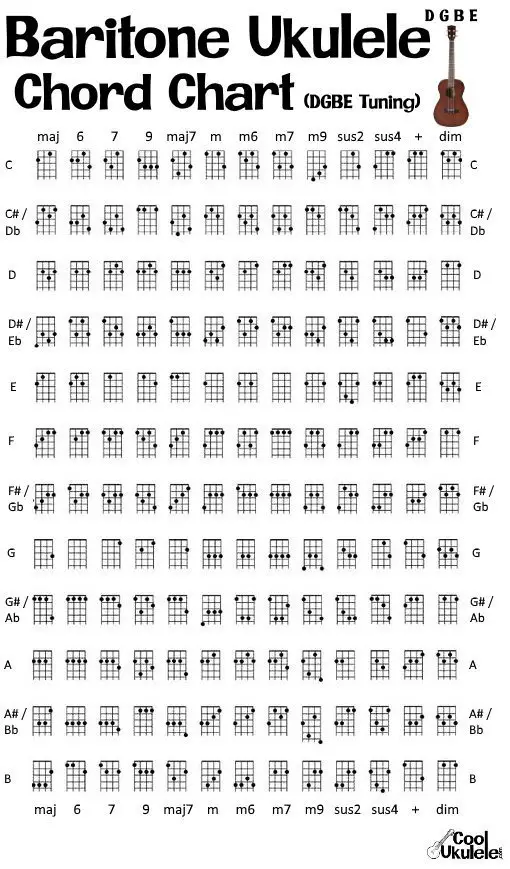
If you’re familiar with guitar chords, you’ll notice the similarity with the baritone chord shapes to the highest 4 strings on the guitar.
If you’re familiar with other sized ukuleles’ chords, you’ll notice the chord shapes are the same, except the Baritone’s chords are a fifth lower (C on Soprano Uke is G on Baritone, etc.)
What is the Scale of a Tuned Baritone Ukulele?
The Baritone Ukulele’s scale (distance from Saddle to Nut) is 19 inches.
This is the part of the strings which vibrates when plucked or strummed.

The vibration frequencies (see above) determine the pitch which our ears hear.
Tuning a string is tightening the string to the frequency required to produce the desired pitch.
What are the Fretboard Notes of a Tuned Baritone Uke?
The Baritone Uke’s fretboard increases 1 half step for each fret. So the open strings’ notes are DGBE, the 1st fret notes are D#/Eb, G#/Ab, C, and F. etc.
The following is a fretboard note chart for the tuned baritone uke up to the 15th fret.
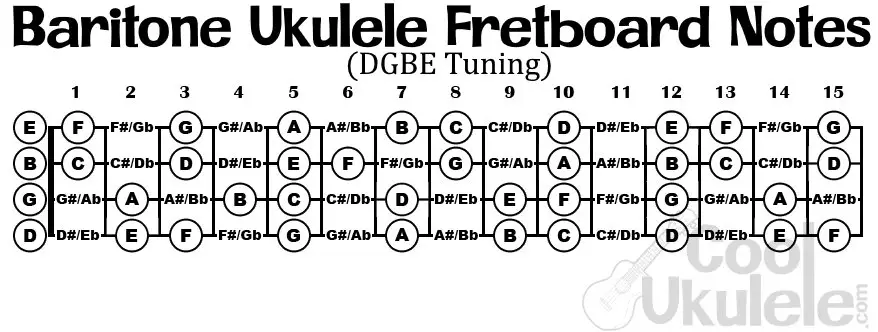
And here’s the old version which was harder to read but may be useful for someone.
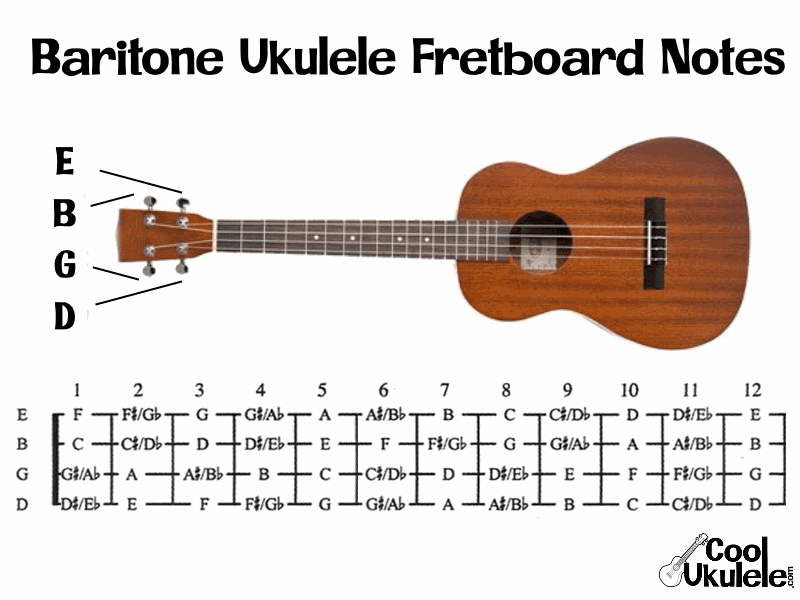
Pineapple Baritone Ukulele Tuning
Pineapple body-shaped ukuleles are similar to the standard wood body ukuleles except there are no indents on the sides of the body. It’s pineapple shaped.
Pineapple Baritone Ukes, though rare, do exist. They are tuned identically to their standard bodied cousins (see above for instruction).
For more info on the pineapple ukulele and how it compares to the standard, check out our Pineapple Ukulele vs. Standard article.
How to Tune the Baritone Ukulele
Of all the ukuleles, Baritone Ukes are the outliers.
This is because their tuning system is so different from the others.
Sometimes it can be hard to find info on tuning the Baritone because so much ukulele instruction material is written for GCEA tuning rather than DGBE, which is the system the Baritone uke is tuned in.
More specifically these notes are: D3, G3, B3, and E4.
Using a Guitar Tuner for Tuning a Baritone Uke
This is a really useful trick for tuning a baritone ukulele if you have a guitar tuner.
Because the 4 strings of the Bari-uke are tuned identically to a guitars’ strings, you can use any tuning gear you have for guitar tuning to tune the uke.
Just disregard the lowest 2 guitar strings.
Alternative Baritone Ukulele Tunings
The baritone ukulele can be tuned with re-entrant D, G, B, E tuning as well as either G, C, E, A tuning system typically used on other ukuleles.
This will require new strings (just the D string for the re-entrant DGBE and completely new strings for either GCEA tuning).
Sometimes baritone ukes are sold with these alternative tunings, but it is much less common than the standard linear DGBE tuning.
How Does the Baritone Ukulele’s Tuning System Compare to Tenor?
The Baritone ukulele is traditionally tuned to D, G, B, E linear tuning, while the tenor is traditionally tuned to G, C, E, A re-entrant.
For a more in-depth comparison, check out the Baritone Ukulele vs. Tenor article.
Baritone Ukulele Tuning Mechanisms
As with other ukulele sizes, you have a few choices when it comes Baritone ukulele tuning mechanisms.
The two main types are defined by their function, they are Geared Tuners (a.k.a. Machine Head Tuners) and Friction Tuners.
Geared Tuners
Geared tuners use 2 gears each to hold the string to the desired tightness. One gear is attached to the shaft which holds the string and the other to the shaft with the tuning head (the part which is turned to adjust the tuner).
The two common types of geared tuners are Open and Sealed:
In Open Geared Tuners, the gears are exposed. This allows for easy cleaning and adjustments, but also means the the gears are more exposed to getting dirty or damaged.

Sealed Geared Tuners, on the other hand, have a case around the gears to keep them clean and protected. The advantage is they won’t need to be cleaned/adjusted as often, but it will be a more difficult task if they do. require maintenance.
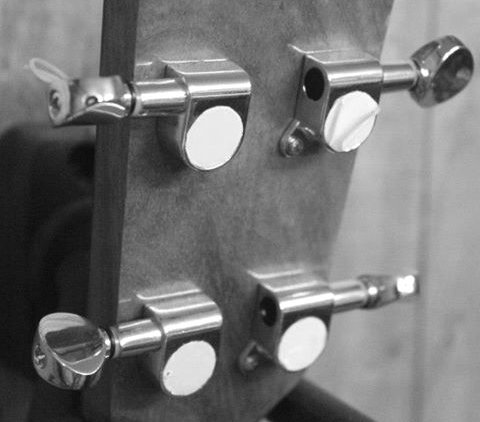
Friction Tuners
Friction tuners use a single-shaft design where the tuning head and string are both on the same shaft which is held in place by friction.

Friction tuners generally each have a screw on the back which can be tightened or loosened to adjust the friction (or hold) of the string.
Frequently Asked Questions
- What is a baritone ukulele?
- A baritone ukulele is the largest of the four common ukulele sizes and is known for its deep and rich tone.
- How many strings does a baritone ukulele typically have?
- A baritone ukulele typically has four strings, like other ukulele sizes.
- What is the standard tuning for a baritone ukulele?
- The standard tuning for a baritone ukulele is D-G-B-E, from top to bottom. It’s the same as the top four strings of a guitar.
- Is baritone ukulele tuning different from other ukulele sizes?
- Yes, baritone ukuleles are typically tuned differently from soprano, concert, and tenor ukuleles, which use G-C-E-A tuning.
- What is the advantage of the baritone ukulele’s tuning?
- The D-G-B-E tuning of a baritone ukulele offers a wider tonal range and allows for deeper, guitar-like chords.
- Can I use a chromatic tuner to tune my baritone ukulele?
- Yes, a chromatic tuner can help you accurately tune your baritone ukulele to the desired pitches.
- What is the best way to tune a baritone ukulele to standard tuning (D-G-B-E)?
- You can use an electronic tuner or tune by ear, starting with the reference pitches for each string.
- What are the reference pitches for each string of a baritone ukulele in standard tuning?
- The reference pitches are D for the fourth (lowest) string, G for the third string, B for the second string, and E for the first (highest) string.
- How do I adjust the tension of the strings to achieve the correct pitch when tuning a baritone ukulele?
- Turn the tuning pegs clockwise to tighten the string and raise its pitch or counterclockwise to loosen and lower the pitch.
- Are there any common tuners specifically designed for baritone ukuleles?
- While there are tuners suitable for all ukulele sizes, there aren’t typically tuners specifically labeled for baritone ukuleles, as they share the same tuning as the top four strings of a guitar.
- How can I ensure my baritone ukulele stays in tune for extended periods?
- Regularly check and adjust the tuning, especially if you change strings or experience temperature and humidity fluctuations.
- Can I use alternate tunings on a baritone ukulele, similar to other ukulele sizes?
- Yes, you can use alternate tunings on a baritone ukulele, but keep in mind that it’s commonly tuned to D-G-B-E.
- What is the relationship between baritone ukulele tuning and guitar tuning?
- The standard tuning of a baritone ukulele (D-G-B-E) is identical to the top four strings of a guitar (D-G-B-E), but the pitches are one octave higher on the ukulele.
- Are there any specialized techniques for fine-tuning a baritone ukulele by ear?
- You can use reference pitches from another instrument, like a piano or a guitar, to match the strings’ pitches by ear.
- Are there electronic clip-on tuners available for baritone ukuleles?
- Yes, clip-on tuners that attach to the headstock of a baritone ukulele are widely available and can be quite accurate.
- What is the benefit of using an electronic tuner for tuning a baritone ukulele?
- Electronic tuners provide precise feedback, making it easier to achieve accurate and stable tuning.
- What should I do if my baritone ukulele goes significantly out of tune?
- If your ukulele goes out of tune, use your tuner to bring each string back to its correct pitch.
- Can I tune a baritone ukulele to other alternative tunings?
- Yes, you can experiment with various alternative tunings to achieve different musical effects on a baritone ukulele.
- Should I tune my baritone ukulele differently for specific songs or styles of music?
- You can consider using alternative tunings to match specific songs or create unique sonic textures.
- Are there any online resources or apps that provide baritone ukulele tuning assistance?
- Yes, there are online tuners and smartphone apps designed to help you tune your baritone ukulele accurately.
- Can temperature and humidity affect the tuning stability of a baritone ukulele?
- Yes, extreme temperature and humidity changes can cause the strings to expand or contract, affecting the tuning. Store your ukulele in a stable environment.
- Is it possible to tune a baritone ukulele by comparing the strings’ pitches to each other rather than using a reference pitch?
- Yes, you can tune a baritone ukulele by matching the pitches of the strings relative to one another, although using a reference pitch is more accurate.
- What is the most common method for tuning a baritone ukulele, by ear or with a tuner?
- Using an electronic tuner is the most common and precise method for tuning a baritone ukulele.
- Are there any specific techniques for stretching new strings on a baritone ukulele to improve tuning stability?
- After installing new strings, gently stretch them by pulling on each string to help them settle and hold their pitch better.
- Is it necessary to tune my baritone ukulele differently when playing with other musicians?
- It’s important to ensure that your baritone ukulele is in tune with other instruments or musicians you’re playing with, so tuning adjustments may be needed.
- What are some common challenges beginners face when tuning a baritone ukulele?
- Beginners may struggle with accurately identifying pitch by ear or may not be familiar with the reference pitches for each string.
- Are there any maintenance tips for keeping the tuning pegs of a baritone ukulele in good working condition?
- Occasionally apply a small amount of lubricant (like graphite) to the tuning pegs to ensure they turn smoothly and hold tuning well.
- Can I use a smartphone app as a tuner for my baritone ukulele, and are they accurate?
- Yes, there are smartphone apps that function as tuners, and many of them are accurate enough for tuning a baritone ukulele.
- What is the best way to check the intonation of a baritone ukulele once it’s tuned?
- Check the intonation by playing open strings and comparing their pitch to the same notes played at the 12th fret. They should match.
- Is it common for strings to slip out of tune when playing a baritone ukulele, and how can I address this issue?
- Strings can occasionally slip out of tune due to factors like string stretching or temperature changes. Regular tuning adjustments and proper string installation can help address this issue.
Conclusion
Well there you have it! Hopefully we’ve covered whatever Baritone Ukulele tuning topic you were searching for.
If not, be sure to leave a comment and let us know what we missed!

